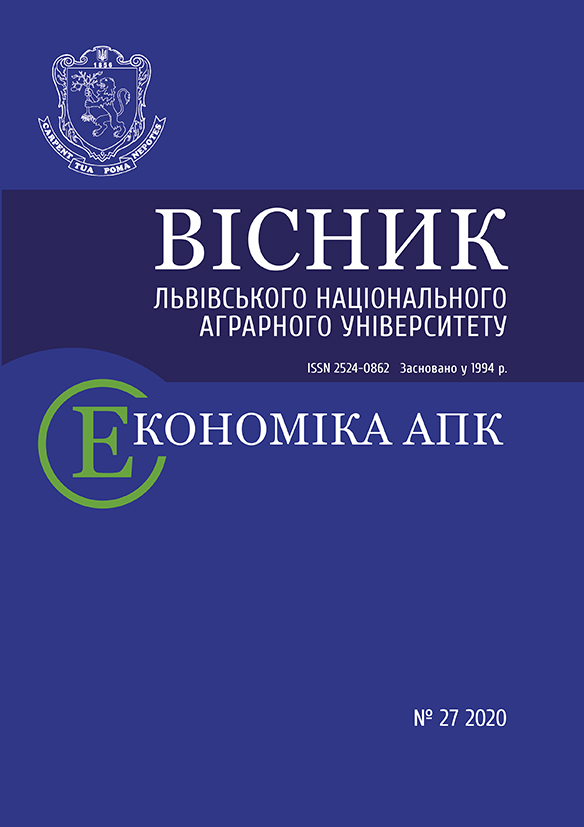Visnyk LNAU: Agronomy 2019 №23: 238-243
Methodology of determination of intensity of soil burial and emission loss of carbon agro-landscapes of left bank in Polissya the event of a plane vegetation period
Trofymenko P., Candidate of Agricultural Sciences
ORCID ID: 0000-0002-7692-5785
Trofimenko N., Phd in Economics
ORCID ID: 0000-0002-2086-1225
Taras Shevchenko National University of Kyiv
Veremeyenko S., Doctor of Agricultural Sciences
ORCID ID: 0000-0003-4513-0733
National University of Water and Environmental Engineering
Borysov F., Candidate of Technical Sciences
ORCID ID: 0000-0003-4871-1269
Zhytomyr National Agroecological University
https://doi.org/10.31734/agronomy2019.01.238
Annotation
In the work the issues of development of the methodology of determining the intensity of soil respiration (ISR) and emission of carbon losses by agrolandscapes of the Left Bank Polissya of Ukraine at the end of the vegetation period are discussed.
It was established that the increase of carbon dioxide concentration in practically all soil abnormalities occurred approximately in accordance with the step function. From 20-25 minutes of exposure in each of the isoterms, there was a slight bend, which was the so-called «saturation effect», which arose as a result of an increase in the concentration inside the chamber and the gradual inhibition of its production by the soil.
According to the data obtained, the highest intensity of carbon dioxide emission was observed on peat-marsh soils, which is associated with a significant amount of organic matter in it and the passage of active processes of its decomposition.
The values of ISR for the studied soils, kg/ha / h, were established: sod-podzolic sandy soil on the ancient alluvium (arable land) 3,0 ± 0,28, (forest band) 3,55 ± 0,33; light gray podzolized sandy soils on loess-like sediments (maize) 3,08 ± 0,29; meadow gleyic coarse-dusty-light-loam soil on modern alluvial deposits (hayfield) 2,76 ± 0,28; peat-boggy well-decomposed soils on modern alluvial deposits, marshes 10,70 ± 0,38. It was established that the intensity of the production of C-CO2 by soddy podzolic binder sandy soil under field-protected forest poles exceeded the corresponding value on arable land by 15,5%, which is due to a larger, compared with corn root pine mass and favorable abiotic conditions in the atmosphere adjacent to the layer soils.
It is shown that the promising direction of scientific research is a scientifically grounded prediction of changes in the volumes of C-CO2 emission from soils, depending on their belonging to certain agricultural lands in the context of climate change transformation.
Key words
СО2 emissions, Polissya soil, carbon, methodology, ISR
Link
- Baker J. M., Oshsner T. E., Venterea R. T., Griffis J. T. Tillage and soil carbon seguestration – what do we really know? Tillage and soil carbon seguestration – what do we really know? Agriculture, Ecosystems and Environment. 2007. Vol. 118. Р. 1–5.
- Chamard P., Thiery F., di Sarra A. et al. Interannual variability of atmospheric CO2 in the Mediterranean: Measurements at the island of Lampedusa. Tellus, 55B. P. 83–93.
- Decree CMU of 14 April 1999 р. № 583 «About the Interdepartmental Commission for the implementation of the UN Framework Convention on Climate Change».
- Decree CMU of 10 of April 2006 р. № 468 «On the Procedure for Coordination of Measures to Implement Ukraine's Obligations under the United Nations Framework Convention on Climate Change and the Kyoto Protocol to the said Convention».
- Decree CMU of 17 of April 2008 р. № 392 «On ensuring compliance with Ukraine's international obligations under the United Nations Framework Convention on Climate Change and the Kyoto Protocol to it».
- Decree CMU of 21 of April 2006 р. № 554 «On Approval of the Procedure for the Functioning of the National Assessment System for Anthropogenic Emissions and Absorption of Greenhouse Gases not Regulated by the Montreal Protocol on Substances that Deplete the Ozone Layer».
- Intergovernmental Panel on Climate Change. United Nations framework convention on climate change. 1992.
- Law of Ukraine № 435/96-SC of 29.10.96, HSC, 1996, № 50, ст.277 «United Nations Framework Convention on Climate Change» signed on behalf of Ukraine on June 11, 1992 at the United Nations Conference on the Environment in Rio de Janeiro.
- Law of Ukraine № 1430-IV (1430-15) of 04.02.2004 «The Kyoto Protocol to the United Nations Framework Convention on Climate Change, signed on behalf of Ukraine on March 15, 1999 in New York».
- Panikov N. S., Solov'yev G. А., Afremova V. D. Biological productivity of systematically fertilized hay meadows on alluvial meadow soil. Moscow University Bulletin. series. Soil science. 1989. № 1. С. 58–66.
- Siabruk E. P. Influence of natural and anthropogenic factors on the dynamics of CO2 emissions from chernozems in the conditions of the Left Bank Forest-steppe of Ukraine: dissertation … degree in Candidate Agricultural Sciences. Kharkiv, 2015. 167 p.
- Tans P. P. Accounting of the Observed Increase in Oceanic and Atmospheric CO2 and an Outlook for the Future. Oceanography. 2009. Vol. 22, 4. P. 26–35.
- Trofimenko P. І., Borysov F. I. Scientific substantiation of the algorithm of the chamber static method for determining the intensity of greenhouse gas emissions from the soil. Agrochemistry and soil science. 2015. № 83. P. 17–24.



